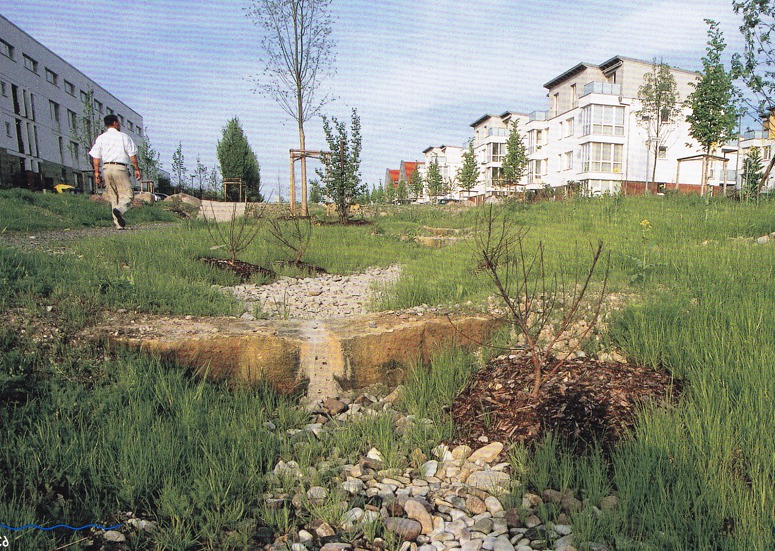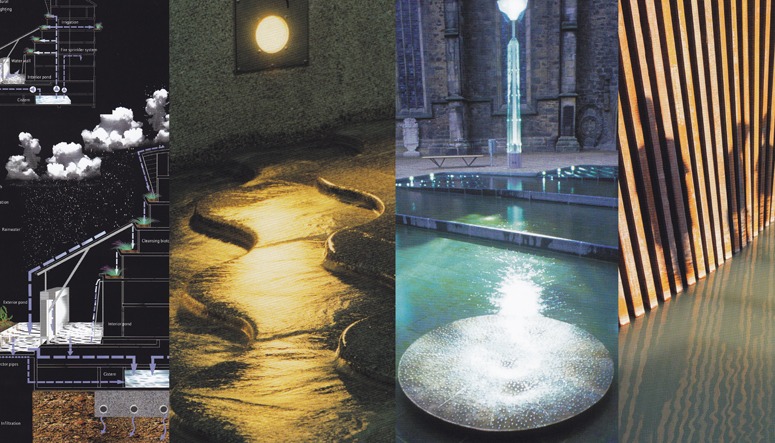Lewis Mumford, in his introduction to Ian McHarg‘s Design with Nature, wrote that ‘It is in this mixture of scientific insight and constructive environmental design, that this book makes its unique contribution’. It was a perceptive remark and I would like to pay a similar comment to the books which Herbert Dreiseitl has published with the title Waterscapes: Herbert Dreiseitl combines scientific insight with an ethical concern for sustainability and an enthusiasm for artistic creation. See Herbert Dreiseitl biography & cv. Waterscapes is already on our list of 100 best books on landscape architecture and in 2009 Dreiseitl published Recent Waterscapes.
Dreiseitl has the scientific insight to understand the water cycle and the negative impacts upon it from poorly conceived urbanisation. He also practices constructive environmental design and he makes a unique contribution. Landscape architecture would be a far stronger profession if more designers were able, simultaneously, to make the world more sustainable and more beautiful. But is it art? and, indeed, What is art? Leo Tolstoy asked this question and, in the Wiki summary: ‘According to Tolstoy, art must create a specific emotional link between artist and audience, one that “infects” the viewer.’ The Wiki entry on Art, begins as follows: ‘Art is the product or process of deliberately arranging symbolic elements in a way that influences and affects the senses, emotions, and/or intellect. It encompasses a diverse range of human activities, creations, and modes of expression, including music, literature, film, photography, sculpture, and paintings.’ I think Dreiseitl passes these tests but I also remember Tracey Emin‘s declaration that one of her works was art ‘because I say it is art’. Dreiseitl could pass this test – and I think he should have a go at it, with a better explanation than Emin. He could say that he has analysed the nature of the world’s watery aspect and found a way of expressing his view in a 3-dimensional and visually dramatic way which depends upon the exercise of hard-won skills. His water sculptures are made in a studio at a 1:1 scale and then cut in granite. Similarly, Rodin worked in clay and had his sculptures cut in marble or cast in bronze. Rodin’s interest was sex; Drieseitl’s is also concerned with the future of life on earth. But my account of his work will not do: Dreiseitl needs to pen an account of ‘why I am an artist’ – and he should exhibit sculptural work in galleries so that it appears in catalogues and passes the commercial test for a work of art.
My favourite projects from Herbert Dreiseitl’s Recent Waterscapes, from left to right, below are:
The Nuremberg Prisma, Hannoversch Munden, Town Square in Gummersbach, Tanner Springs Park in Portland,
There is one problem with Dreiseitl’s projects: the vegetation is often managed on a habitat-creation basis and this tends to look ragged in the early years. In the fullness of time, they may well become beautiful semi-natural habitats. But one wonders if there is a way of making them more beautiful in the early years. The example below is a rainwater retention scheme on the Kronsberg in Hanover, Germany.




My urban water aesthetic tends to be more zen/mimimalist than Driseitl’s usual work, so I have picked out favourite examples to illustrate:
[ http://www.dreiseitl.net/cms-gfx/58_Paragon/017_Paragon_bild_gr.jpg ]
[ http://www.dreiseitl.net/cms-gfx/9_Maybach_Center/009-bild-gr.jpg ]
[ http://www.dreiseitl.net/cms-gfx/30_Gartenfestival-Chaumont-Loire/014_Choum_bild_gr.jpg ]
[ http://www.dreiseitl.net/cms-gfx/2_Hannoversch_Muenden/002-rund-navi-neu.jpg ]
[ http://www.asla.org/uploadedImages/CMS/Business_Quarterly/queens_watercanal.jpg ]
Perhaps integrating external urban areas and internal lobby design would achieve something amazing?
[ http://annarborchronicle.com/wp-content/uploads/2010/07/DreiseitlLobby.jpg ]
Thank you for the discrimination. It is easy to slip into the trap of thinking that a person is ‘good’ and so their work is ‘good’, whereas all work and all people have good and bad aspects.
There is something Rudolph Steiner-ish about some of Dreisitl’s projects and I can see why you admire his Minimalist work and other Minimalist landscape architecture. It has something of the near-religious purity found in Mother Nature’s best moods.
When night is almost done,
And sunrise grows so near
That we can touch the spaces,
It’s time to smooth the hair
Emily Dickinson’s Dawn makes me think of the Prince Genji waking in a pavilion and looking out to a Japanese garden with one of his poetess mistresses – the Wabi-Sabi aesthetic was one of the sources for Western Minimalism.
Yes Lady Murasaki in writing Japan’s first novel in the Heian era was influenced considerably by the newly introduced from China but culturally assimilated Buddhism.
Here is an interesting blog post on Wabi Sabi [ http://www.studiogblog.com/reference-history/wabi-sabi-what-the…..is-that/ ] and some theory. [ http://www.hermitary.com/solitude/aesthetics.html ].
Despite the differences between the aesthetic approaches of Wabi Sabi and Modernism listed here – I believe they sit well together as landscape/architecture.
Since Buddhist ideas originated in Central Asia (South Central and North Central) I think there has been a tendency for both East and West Eurasia to downplay its originality. Also, I think it was a landscape- and garden-influenced set of beliefs. It may be that the man:nature relationship was deeply thought out under the influence of Buddhism. BUT I often find Buddhist art rather tacky!
I wonder how much of this is part of a cultural sensibility?
[ http://www.fwbo-news.org/uploaded_images/Aloka_Buddha_Norwich-709119.JPG ]
True, a British inspired Buddha is more aesthetically palatable than some of the other religious images which are possibly more inaccessible because of their largely symbolic content and mode of representation.
[ http://fwbo-news.blogspot.com/2008/06/major-exhibition-of-western-buddhist.html ]
However, other Buddhist art such as this wooden statute of a Bodhisattva from the Song Dynasty (960-1279) are extraordinarily beautiful for their emotional manifestation of qualities of strength, serenity and inner dignity.
[ http://encyclopedia.thefreedictionary.com/_/viewer.aspx?path=9%2F98%2F&name=Wood_Bodhisattva.jpg ]
Another difficulty as this post demonstrates is the contextualisation of scared art: aesthetically the Kalachakra Cosmology Diagram is challenging as wall painting in isolation – however contextualised with the architecture [ http://tibet-incense.com/blog/kalachakra-cosmology-diagram/ ] the composition takes on different sets of relationships.
With regard to Buddhist sculpture I think part of the problem is that it is painted, as was the case for much sculpture in the ancient world. But I generally like the colours on Egyptian sculpture and I generally do not like the colours on Buddhist sculpture. As you say, this could be ‘cultural’. But I do not like the example of English Buddhist art either. It is the kind of graphic which Time Magazine might use for an article on some aspect of modern Buddhism.
It could be the light quality and the environmental context of the statutes as well as the symbolic representational qualities which determine the use of colour.
[ http://www.talariaenterprises.com/products_lg/tal109.html ] In the ancient world the use of colour was most likely also due to be the availability of pigaments.
This writer has speculated that the colour perception of the ancient Greeks was also very different to ours. [ http://serendip.brynmawr.edu/exchange/node/61 ] It would seem that our cultural epistemology has something to do with how we percieve and appreciate colour.
[ http://einquisitive.com/blog/comparison-of-the-epistemology-of-david-hume-and-immanuel-kant/ ]
Preference is a judgment. So you could tell me why you like something and dislike something else.
For example:
“It is the kind of graphic which Time Magazine might use for an article on some aspect of modern Buddhism.”
However this statement perhaps requires further elaboration on a) the use of graphics by Time magazine and b) how Time might approach an article on modern Buddhism to give it full clarity.